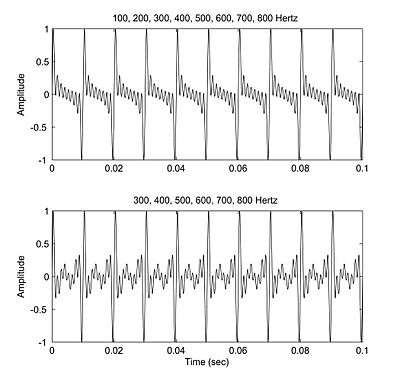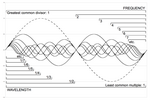Missing fundamental

The pitch being perceived with the first harmonic being absent in the waveform is called the missing fundamental phenomenon.[1]
It is established in psychoacoustics that the auditory system, with its natural tendency to distinguish a tone from another, will persistently assign a pitch to a complex tone given that a sufficient set of harmonics are present in the spectrum.[2]
For example, when a note (that is not a pure tone) has a pitch of 100 Hz, it will consist of frequency components that are integer multiples of that value (e.g. 100, 200, 300, 400, 500.... Hz). However, smaller loudspeakers may not produce low frequencies, so in our example, the 100 Hz component may be missing. Nevertheless, a pitch corresponding to the fundamental may still be heard.
Explanation

A low
It was once thought that this effect was because the missing fundamental was replaced by distortions introduced by the physics of the ear. However, experiments subsequently showed that when a noise was added that would have masked these distortions had they been present, listeners still heard a pitch corresponding to the missing fundamental, as reported by
The pitch of the missing fundamental, usually at the
In Parsing the Spectral Envelope: Toward a General Theory of Vocal Tone Color (2016) by Ian Howell, He wrote that although not everyone can hear the missing fundamentals, noticing them can be taught and learned.[16] D. Robert Ladd et al. have a related study that claims that most people can switch from listening for the pitch from the harmonics that are evident to finding these pitches spectrally. [17]
Examples

A violin's lowest air and body resonances generally fall between 250 Hz and 300 Hz. The fundamental frequency of the open G3 string is below 200 Hz in modern tunings as well as most historical tunings, so the lowest notes of a violin have an attenuated fundamental, although listeners seldom notice this.[citation needed]
Most common
The missing fundamental phenomenon is used electronically by some pro audio manufacturers to allow sound systems to seem to produce notes that are lower in pitch than they are capable of reproducing.[21] In a hardware effects unit or a software plugin, a crossover filter is set at a low frequency above which the sound system is capable of safely reproducing tones. Musical signal content above the high-pass part of the crossover filter is sent to the main output which is amplified by the sound system. Low frequency content below the low-pass part of the crossover filter is sent to a circuit where harmonics are synthesized above the low notes. The newly created harmonics are mixed back into the main output to create a perception of the filtered-out low notes.[22] Using a device with this synthetic process can reduce complaints from low frequency noise carrying through walls and it can be employed to reduce low frequency content in loud music that might otherwise vibrate and damage breakable valuables.[23]
Some
Audio processing applications
This very concept of "missing fundamental" being reproduced based on the overtones in the tone has been used to create the illusion of bass in sound systems that are not capable of such bass. In mid-1999, Meir Shashoua of
Other software and hardware companies have developed their own versions of missing fundamental-based bass augmentation products. The poor bass reproduction of earbuds has been identified as a possible target for such processing.[27] Many computer sound systems are not capable of low bass, and songs offered to consumers via computer have been identified as ones that may benefit from augmented bass harmonics processing.[28]
See also
- Psychoacoustics
- Subharmonic
References
- ISBN 9781315716879.
- ^ Hartmann, William (December 1996). "Pitch, Periodicity, & Auditory Organization" (PDF). Acoustical Society of America. 100 (6): 11 – via Michigan State University.
- ^ "Virtual Pitch Algorithm of Terhardt and Extensions".
- ISBN 978-0-262-11318-2. Archived from the originalon 2012-03-18. Retrieved 2018-08-30.
- ^
John Clark, Colin Yallop and Janet Fletcher (2007). An Introduction to Phonetics and Phonology. Blackwell Publishing. ISBN 978-1-4051-3083-7.
- ^ a b
Christopher J. Plack (2005). Pitch: Neural Coding and Perception. Springer. ISBN 978-0-387-23472-4.
- ISBN 978-0-262-20081-3.
- PMID 8890286. Retrieved 13 November 2012.
- PMID 16838534. Retrieved 13 November 2012.
- S2CID 18133681.
- S2CID 123182480.
- doi:10.1121/1.381166.
- PMID 16419824.
- S2CID 40608136. Archived from the original(PDF) on 2012-12-08. Retrieved 4 September 2012.
- S2CID 16010412. Archived from the original(PDF) on 2017-08-09. Retrieved 2012-07-22.
- ^ Howell, I. (2017). Parsing the Spectral Envelope: Toward a General Theory of Vocal Tone Color[Doctoral Thesis, New England Conservatory of Music]. https://www.nats.org/_Library/So_You_Want_To_Sing_Book_Series/HOWELL-Parsing-the-spectral-envelope-PROQUEST-FINAL.pdf
- PMID 23398251– via Pubmed.
- ^ ISBN 978-0-240-51995-1.
- ^ McGill University. Physics Department. Guy D. Moore. Lecture 26: Percussion Archived 2015-09-24 at the Wayback Machine. "The sequence 1; 1:51; 1:99; 2:44; 2:89 is almost 1; 1:5; 2; 2:5; 3 which is the harmonic series of a missing fundamental."
- ISBN 978-0-86377-835-3. Retrieved May 11, 2010.
- ^ Waves Car Audio. MaxxBass Bass Enhancement Technology
- ^ US 5930373, "Method and system for enhancing quality of sound signal"
- ^ "ProSoundWeb. LAB: The Classic Live Audio Board. Re: maxxbass posts by Doug Fowler June 28-29, 2008". Archived from the original on 2011-05-21. Retrieved 2008-09-03.
- ^ U.S. patent 5,930,373
- ISSN 1522-4279. Retrieved May 11, 2010.
- ^ a b Bundschuh, Paul (April 15–17, 2004). "MaxxBass Applications for Small, Full Range Loudspeakers" (PDF). Loudspeaker University. Nashua, New Hampshire: Waves Audio. Archived from the original (PDF) on July 14, 2011. Retrieved May 11, 2010.
- ^ Arora, Manish; Seongcheol Jang; Hangil Moon (September 2006). "Low Complexity Virtual Bass Enhancement Algorithm For Portable Multimedia Device". AES Conference. Retrieved May 11, 2010.
- ^ Houghton, Matt (April 2007). "Better Bass: The Complete Guide To Recording, Mixing & Monitoring The Low End". Sound on Sound. Retrieved May 11, 2010.
External links
- Pitch Paradoxical Archived 2003-08-13 at the Wayback Machine
- Structural and functional asymmetry of lateral Heschl's gyrus reflects pitch perception preference – abstract of the Heidelberg research, as published in Nature Neuroscience 8, 1241–1247 (2005); downloading the full article requires payment
- How do you hear tones? – discussion forum thread about the Heidelberg research, with a link to a sound file used in the research so that readers can determine whether they are fundamental or overtone hearers

